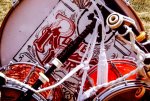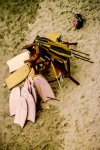Welcome Guest!
You are using an out of date browser. It may not display this or other websites correctly.
You should upgrade or use an alternative browser.
You should upgrade or use an alternative browser.
35 mm color slides
- Thread starter SWAMPFOX
- Start date
Silver Britches
Official Sports Forum Birthday Thread Starter
Hi Swampfox,
What you want to do is very simple. All you need to do is buy yourself a 35mm Film Scanner and scan them yourself. Read this article.
You can buy these scanners almost everywhere, including cheap ones at Walmart. But to get you pointed in the right direction, have a look at the following links.
B&H Photo
Amazon
Best Buy
As far as which scanner would be the best to get, I couldn't tell you, but do pay attention to the customer reviews of them.
I also have a lot of 35mm negatives that I want to preserve and have been thinking of getting one of these scanners to do it. I took a few negatives to Walgreens this past Saturday to have a photo CD made of them and I am very disappointed in the quality. So I wouldn't recommend doing that. Plus, I think you would enjoy doing this yourself.
Do let us know what you decide on and how everything goes. If you have any further questions just let me know.
Good luck!
What you want to do is very simple. All you need to do is buy yourself a 35mm Film Scanner and scan them yourself. Read this article.
You can buy these scanners almost everywhere, including cheap ones at Walmart. But to get you pointed in the right direction, have a look at the following links.
B&H Photo
Amazon
Best Buy
As far as which scanner would be the best to get, I couldn't tell you, but do pay attention to the customer reviews of them.
I also have a lot of 35mm negatives that I want to preserve and have been thinking of getting one of these scanners to do it. I took a few negatives to Walgreens this past Saturday to have a photo CD made of them and I am very disappointed in the quality. So I wouldn't recommend doing that. Plus, I think you would enjoy doing this yourself.
Do let us know what you decide on and how everything goes. If you have any further questions just let me know.
Good luck!
georgia357
Senior Member
I've tried to convert some slides in the past with scanners and wasn't too pleased with the results. Next time, I'm thinking of trying something like ShotCopy. It uses your digital camera to take a picture of the slide.
Silver Britches
Official Sports Forum Birthday Thread Starter
I've tried to convert some slides in the past with scanners and wasn't too pleased with the results. Next time, I'm thinking of trying something like ShotCopy. It uses your digital camera to take a picture of the slide.
Are you talking about a regular flatbed scanner that most everyone has, or one of the dedicated 35mm Film Scanners like I suggested for him to use?
I've seen what the results of a regular flatbed scanner looks like; I've done this myself, and I wasn't happy with the quality either.
A dedicated 35mm Film Scanner like what I am suggesting would scan your negatives and slides with much better results. You may still need to tweak the settings of the scanner to find what looks the best to you. You may also need to spend a little over a $100 to get a 'quality' scanner, but this would still be cheaper than letting a drug store or camera shop do all of them for you. It might even be possible to find someone who owns a photography service that would be willing to do the work at a fair price, certainly doesn't hurt to ask. Just ask to see a 'test' scan to see if the quality is acceptable to you before committing to them.
BERN
Senior Member
I have 2 wolverine film scanners. I used them to scan my grandfathers slides. I was happy with the results. Look them up and I'll be happy to tell you more about them.
georgia357
Senior Member
Are you talking about a regular flatbed scanner that most everyone has, or one of the dedicated 35mm Film Scanners like I suggested for him to use?
I've tried both and was not satisfied with either. This was a couple of years ago and I'm sure that both types are better now, just not willing to pay good money to try them again.
georgia357
Senior Member
I have 2 wolverine film scanners. I used them to scan my grandfathers slides. I was happy with the results. Look them up and I'll be happy to tell you more about them.
Which model did you use, and could you show us an example or two?
BERN
Senior Member
I have the F2D20. I will post examples when I get home this evening. This one makes a 20 Mp .jpg file. Please keep in mind that the file size restrictions on this forum are going to skew the results a bit. I think there is a fairly sharp loss in image quality for everyone on here that is posting images captured with high end sensors.
The one thing to keep in mind is that when you scan slides you have to do a little tweaking in PS or LR (or other editor of your choice). I found the process to be very similar to making cibachrome prints from slides like the old days. Those prints never had the saturation that you could see on a projected image or looking with a loupe on a lightbox. Likewise, a tiny bit of sharpening and bumping the saturation a little makes the scans pop a bit more.
Keep in mind that this is an analog to digital conversion, a second generation image. It likely will never look as good as the original slide or the same image had you just made it with a dslr to start with. I would say the best you could do is to send them out to a scanning service. They would clean them, scan them, color correct them and burn them to a disk for you, all for the low low price of about 0.40 cents a pop.
The one thing to keep in mind is that when you scan slides you have to do a little tweaking in PS or LR (or other editor of your choice). I found the process to be very similar to making cibachrome prints from slides like the old days. Those prints never had the saturation that you could see on a projected image or looking with a loupe on a lightbox. Likewise, a tiny bit of sharpening and bumping the saturation a little makes the scans pop a bit more.
Keep in mind that this is an analog to digital conversion, a second generation image. It likely will never look as good as the original slide or the same image had you just made it with a dslr to start with. I would say the best you could do is to send them out to a scanning service. They would clean them, scan them, color correct them and burn them to a disk for you, all for the low low price of about 0.40 cents a pop.
BERN
Senior Member
My apologies. I ended up working late last night and did not get the opportunity to post any scans. I'll try again for tonight. Thank you for your patience.
BERN
Senior Member
scans
Here are a couple of scans. These images were made in 1987. As I suspected, reducing them to the 460 Kb limit for the forum makes it hard to tell from this example.
I don't know anyone's preference for quality. For my money this is pretty good. It does take a little bit of post to get the most out of them.
One other thing to consider is that as I look through my old slides I see minute camera shake, DOF problems and other things I didn't realize were there 30 years ago. You can't zoom in as far with a loupe as you can with photoshop!
Here are a couple of scans. These images were made in 1987. As I suspected, reducing them to the 460 Kb limit for the forum makes it hard to tell from this example.
I don't know anyone's preference for quality. For my money this is pretty good. It does take a little bit of post to get the most out of them.
One other thing to consider is that as I look through my old slides I see minute camera shake, DOF problems and other things I didn't realize were there 30 years ago. You can't zoom in as far with a loupe as you can with photoshop!
Attachments
Good info folks - thanks for sharing. I have in the past just projected the slides onto a white screen and taken a digital image of the projected image on the screen. Worked okay for my training needs to create power point presentations.
georgia357
Senior Member
I'd be very pleased if I could get mine to look like yours did BERN, looks good.
Similar threads
- Replies
- 20
- Views
- 1K
- Replies
- 4
- Views
- 462
- Replies
- 100
- Views
- 5K
- Replies
- 10
- Views
- 806


